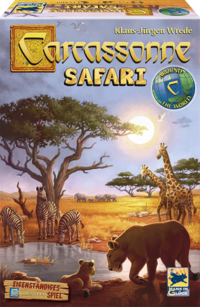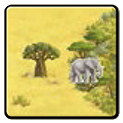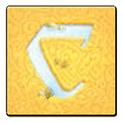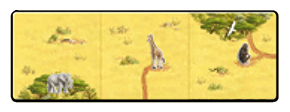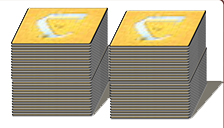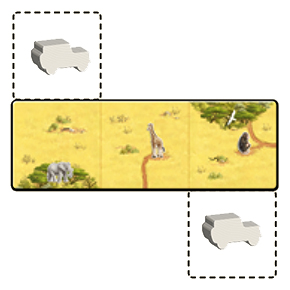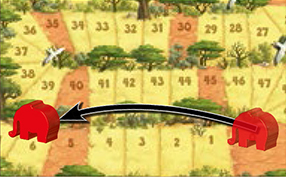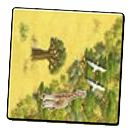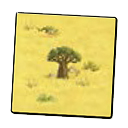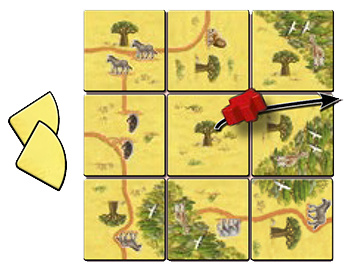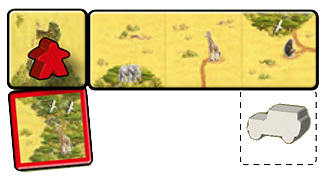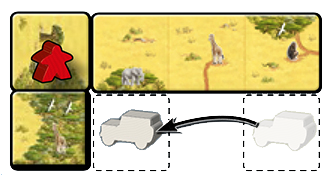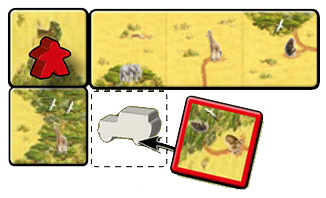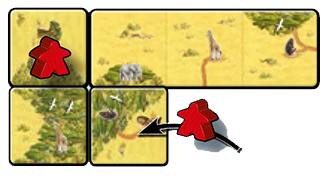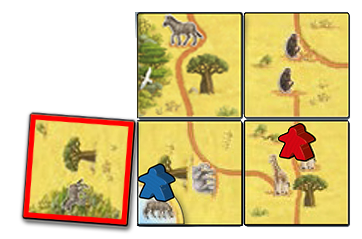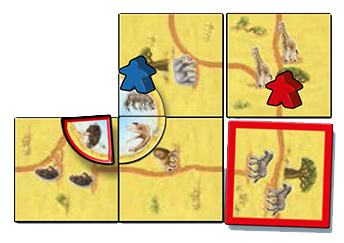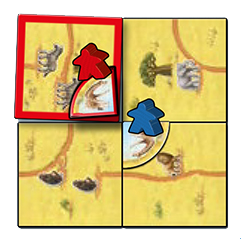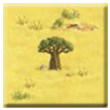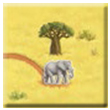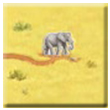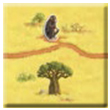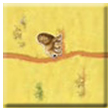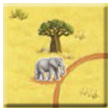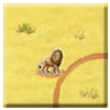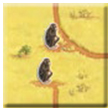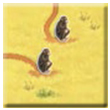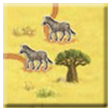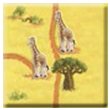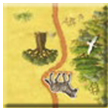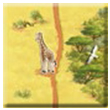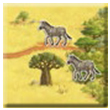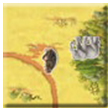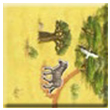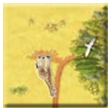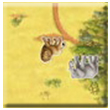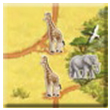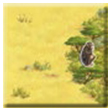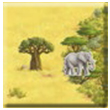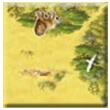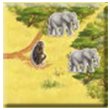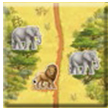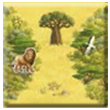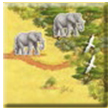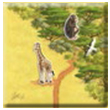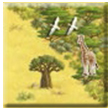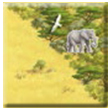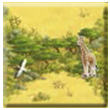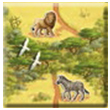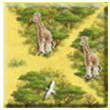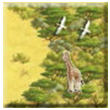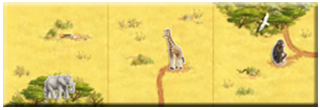Safari: Jocul de bază
Africa nădușește sub soarele aprins, dar te îmbie o aventură în savană! Maimuțele se leagănă în copaci, leii se odihnesc la umbră, iar pământul se zguduie sub pași răsunători ai elefanților. În timp ce animalele se adună absolut toate la găurile de adăpare, fă o drumeție prin hățiș, stai la pândă și vezi maiestatea naturii desfășurându-se!
Informații generale și comentarii
Safari a fost lansat original de Hans im Glück în 2018.
O notă asupra titlului: Astăzi, termenul „safari” este folosit în principal pentru a descrie observarea animalelor sălbatice în habitatul lor natural și este folositpe de-a-ntregul cu acest sens.
Componente și configurare
Componente
- 72 de cartonașe de teren ce ilustrează peisajul savanei, trasee de animale, baobabi și hățișul unde se strâng animalele.
- 1 cartonaș de pornire cu mărimea a trei cartonașe de teren.
- 50 de cartonașe de gaură de adăpare / de animal ce ilustrează cele cinci animale mari diferite. Fiecare animal este reprezentat pe zece cartonașe. Patru cartonașe de animale pot fi conectate pentru a crea o gaură de adăpare.
- Tablă de punctaj
- 5 marcatoare de punctare ce arată 50 și 100
- 30 meepleși, șase în fiecare dintre următoarele culori: galben, roșu, verde, albastru și negru
- 5 elefanți, câte unul în culoarea fiecărui jucător
- 2 vehicule de teren albe - acestea sunt doi pioni neutri denumiți „vehicule” pe tot parcursul regulilor. Nu aparțin niciunui jucător.
Pregătire
Amestecă toate cele 72 de cartonașe de teren și plasează-le cu fața în jos în stive care sunt la îndemâna tuturor jucătorilor.[1]
Plasează cartonașul de pornire în mijlocul mesei și plasează vehiculele în spațiile indicate în ilustrația de mai jos.
Plasează tabla de punctaj șa marginea suprafeței de joc. Plasează marcatoarele de punctaj lângă aceasta.
Amestecă toate cele 50 de jetoane de animal și distribuie două fiecărui jucător. Fiecare jucător le pune cu fața în sus în fața sa. Amestecă restul acestora și pune-le deoparte, cu fața în jos.[2]
Fiecare jucător alege o culoare și ia cei șase meepleși și un elefant de acea culoare că să formeze rezerva sa personală. Plasează elefantul fiecărui jucător pe câmpul 0. Înapoiază toți meepleșii și elefanți nefolosiți în cutie.
Prezentare generală și obiectivul jocului
Jucătorii efectuează ture plasând cartonașe de teren, extinzând savana și descoperind hățiș, trasee de animale și baobabi. Plasezi meepleși în hățiș sau pe trasee de animale și le finalizezi pe acestea pentru a încasa puncte pentru diferitele animale prezente și culci meepleși pe baobabi pentru a trage noi cartonașe de animal. Cartonașele de animale pot aduce puncte adiționale sau pot fi folosite pentru a săpa găuri de adăpare în savană. Jucătorii încasează puncte pe tot parcursul jocului, precum și la sfârșitul jocului. Câștigă jucătorul cu cel mai mare punctaj după evaluarea finală.
Desfășurarea jocului
Carcassonne Safari este jucat în ture, în ordinea acelor de ceasornic. Începând cu cel mai tânăr jucător, jucătorul activ urmează acești pași în ordinea listată mai jos, după care următorul jucător efectuează o tură și așa mai departe. Mai jos este o scurtă descriere a acțiunilor pe care le vei efectua într-o tură și diferitele teritorii de pe cartonașele de teren.
Traseele de animale
1. Atașarea unui cartonaș de teren cu un traseu de animale
Dacă tragi un cartonaș cu un traseu de animale, trebuie să îl plasezi astfel încât să continue peisajul existent (incluzând orice savană, trasee de animale sau hățiș).[3]
2. Plasarea unui meeple pe un traseu de animale
După ce plasezi un cartonaș cu un traseu de animale, ai posibilitatea de a plasa unul dintre meepleșii tăi pe acel traseu de animale, dar numai dacă nu este prezent niciun alt meeple de-a lungul întregului traseu.
3. Evaluarea unui traseu de animale
Un traseu de animale este finalizat atunci când ambele capete sunt închise de hățiș sau savană sau atunci când se întoarce în sine însuși conectându-se de celălalt capăt. Atunci când este finalizat traseul, este evaluat. Dacă unul dintre meepleșii tăi este pe un traseu atunci când acesta se evaluează, vei încasa puncte de pe urma acestuia.
Încasezi puncte pe baza numărului de animale diferite prezente pe traseul de animale. Numărul punctelor încasate este afișat mai jos, precum și pe tabla de punctaj.
Numărul total de animale de pe traseu nu contează, numai câte animale diferite sunt prezente. După evaluare, înapoiază meepleul tău de pe traseu în rezerva ta.
Plasarea de animale adiționale
Înainte să încasezi puncte de pe urma unui traseu de animale, ai posibilitatea de a adăuga 1 cartonaș de animal din rezerva ta pe acel traseu. Cartonașul de animal trebuie să fie un animal care nu este deja prezent pe acel traseu.
Jucătorii țin socoteala punctajelor lor folosind elefanții plasați pe tabla de punctaj la începutul jocului. Atunci când încasezi puncte, mută-ți elefantul înainte atâtea câmpuri. Dacă elefantul tău trece de câmpul 0 de pe tabla de punctaj, ia un marcator de punctare și plasează-l cu partea „50” în sus în fața ta. Dacă elefantul tău trece câmpul 0 din nou, întoarce marcatorul de punctare pe cealaltă parte pe partea „100”.
Respinge toate cartonașele de animale care au fost plasate pe traseu cu fața în sus. Dacă un jucător ar trage un nou cartonaș de animal, dar nu a mai rămas niciunul în rezervă, amestecă cartonașele respinge cu fața în jos pentru a crea noua rezervă.
Hățișul
3. Scoring a feature
A bush is completed when it does not have any open sides or gaps. When a bush is completed, it is scored. If one of your meeples is in the bush when it scores, you will score points from it. The points scored from animals in a bush are the same as those scored from
an animal trail (see table below). Additionally, each bird (![]() ) above the bush is worth 1 point.
) above the bush is worth 1 point.
After scoring a bush, return your meeple from the bush to your supply.
Placing additional animals
Before you would score points from a bush, you may add one animal tile from your supply on that bush. The animal tile must be an animal that is not already present in that bush, and the animal tile is discarded after the bush is scored.
The Baobab Tree
3. Scoring a feature
When all eight spaces around a baobab tree have tiles placed on them, return your meeple from that tree to your supply, then draw two additional animal tiles from the supply and place them faceup in front of you. You do not score any points from the baobab tree.
Regulă provizorie - notă pe subiectul regulilor provizorii
Since animal tokens for completing a baobab are received in the scoring phase, it is unclear at this moment if the player can use either of the two animal tokens in the same turn to boost the score of another, scoreable, feature, if it is completed by placing the tile. We recommend allowing immediate use. Alternatively, you can use an animal token received for placing a meeple on a baobab in a previous phase.
The Ranger
During your turn, the rangers can be used in one of two ways:
- Option A: The tile does not displace a ranger
3a. Score features
Score all features completed by the tile you placed. You do not score points for moving the ranger.
- Option B: The tile displaces a ranger
Note: You may only move one ranger per turn. If you displaced a ranger with your tile (1b), you may not move a
ranger instead of placing a meeple (2a). The two rangers can never occupy the same space.
The Watering Holes
In addition to using animal tiles to improve your score for animal trails and bush, you can also use them to dig watering holes in the savanna.
1. Placing a land tile
You draw a land tile and place it, continuing the landscape as normal.
2. Dig or expand a watering hole
Dig a watering hole
Instead of placing a meeple on a tile, you may start digging a watering hole. To do so, place an animal tile from your supply onto an open corner of any tile (not necessarily the tile you just placed). A corner is open if it depicts only savanna (no bush). Then place a meeple on that animal tile and immediately score 3 points.
![]() Întrebare: The rules say that you can start a Watering Hole at the empty savanna corner of a tile. However, once a Watering Hole has started, can a player place a tile with Bush segment next to the Watering Hole? See the picture below.
Întrebare: The rules say that you can start a Watering Hole at the empty savanna corner of a tile. However, once a Watering Hole has started, can a player place a tile with Bush segment next to the Watering Hole? See the picture below.
If a player places a Bush segment there, the Watering Hole can never be completed, and the meeple is stuck for the rest of the game. Is this allowed?
Expanding a watering hole
Instead of placing a meeple on the tile you just placed, you may expand a watering hole. Place an animal tile onto a land tile such that it continues to close the circle of the watering hole.
You must use an animal tile depicting a different animal than the animals already present at the watering hole. You do not place a meeple onto this animal tile.
Depending on whether you placed the second, third, or fourth (and last) animal tile on a watering hole, you score points as follows:
- Second animal tile: 4 points
- Third animal tile: 5 points
- Fourth animal tile: 6 points
Note: You may not start digging a watering hole without placing a meeple on it.
Exception: You may start digging a new watering hole diagonally across from an existing watering hole. Since the animal tiles do not touch yet, you place a meeple on this tile. Once the watering hole is complete, two meeples will occupy it. In this instance, it is possible for two of the same animal to occupy the watering hole.
Regulă provizorie - notă pe subiectul regulilor provizorii
Although the animal tokens may, at some later point, be connected to form a single waterhole, this token begins a new watering hole, so the player receives 3 points.
3. Scoring a watering hole
When the fourth animal tile of a watering hole is placed, it is complete. The owner of the watering hole scores three points. If two meeples occupy the watering hole, both players score three points. If both meeples belong to the same player, that player still only scores 3 points.
Return all meeples from the watering hole to their owners.
Multiple meeples on the same feature
Although you may not place a meeple on a feature (an animal trail or bush) that is already occupied by a meeple, it is possible that, by connecting separate features, multiple meeples will occupy the same feature. When a feature with multiple meeples on it is scored, only the player with the most meeples on that feature scores points. If there is a tie for the most meeples on a feature, all tied players score the full amount of points. If multiple players have meeples on the same feature, all scoring players may add a different animal to the feature before scoring. Animal tiles only add to the score of the player who placed them.


Summary
1. Placing a Land tile
- You must place the tile you drew such that it continues the landscape and connects with existing features.
- If you are unable to place the tile you drew, return it to the box and draw a new one.
- If you place a tile in a space occupied by a ranger, you displace the ranger.
2. Placing a meeple
- You may place a meeple only on a feature on the land tile you just placed. When doing so, you must ensure that another meeple is not already occupying the feature you are placing on.
- If you lay a meeple on a baobab tree, you draw two animal tiles.
- If you do not place a meeple, you may instead dig a new watering hole, expand a watering hole, or move a ranger.
3. Scoring a feature
- Completed features are scored at the end of each turn. After scoring, players return their meeples from the scored features to their supply.
- A completed animal trail scores points based on the number of different animals present.
- A completed bush scores points in the same way as a completed animal trail, plus 1 point per bird.
- A completed baobab tree allows you to draw two additional animal tiles.
- A completed waterhole scores 3 points. [4]
- Placing a ranger after being displaced by the tile just placed scores 3 points. [4]
- If there are multiple meeples on a single scored feature, the player with the most meeples is the only one who scores. If multiple players are tied, the tied players all score full points.
Game end and final scoring
The game ends after a player draws the last land tile. That player takes their turn, then final scoring is conducted as follows:
- Animal trails and bush
- The player with the most meeples on the feature scores 1 point for every animal and bird present. Different types of animals do not matter. [5]
- Animal tiles
- You score 1 point for each animal tile in your supply.
- Baobab trees and watering holes
- Meeples on baobab trees and watering holes do not score points.
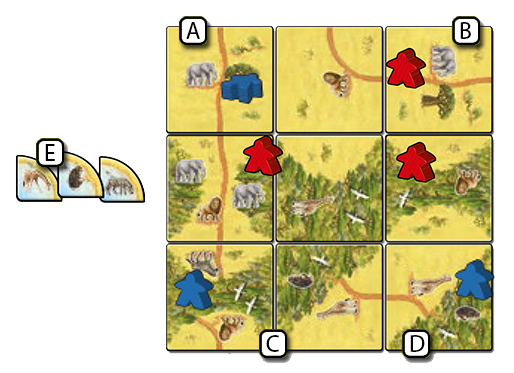
A: Blue does not score any points for the meeple on the baobab tree.
B: You score 2 points for the two animals on the trail.
C: You and Blue have meeples in the large bush. Since you has more meeples than Blue there, you get the points for the animals. With four animals and six birds in the bush, you score 10 points. [6]
D: Blue scores 2 points for the one animal (ape) and one bird in the small bush.
E: You score 3 points for animal tiles in your supply.
After final scoring is complete, the player with the most points wins. If multiple players are tied, they share the victory. [7]
Folosirea unei mese
A fost pus un număr de întrebări despre reguli legate de suprafața de joc însăși,[8] incluzând ce se întâmplă când este atinsă marginea suprafeței sau dacă trebuie folosită o masă pentru joc. Următoarele clarificări sunt de la Georg Wild de la HiG (5/2013):
- Marginea mesei este limita jocului dacă, așa cum este stabilit în reguli, este folosită o masă.
- Regulile spun că cartonașul de pornire este așezat în mijlocul mesei. Dacă toate cartonașele sunt mutate pentru a permite mai mult spațiu, cartonașul de pornire nu va mai fi în mijloc. Așa că în principiu, mutarea totală a cartonașelor nu este permisă. În plus, cu o deplasare manuală a tuturor cartonașelor, cartonașele și pionii de pe suprafața de joc pot aluneca, ceea ce ar putea duce la o poziționare incorectă a cartonașelor sau a pionilor.
- Adăugarea altei mese este posibilă dacă este adăugată una de înălțime apropiată. Dacă o masă este extinsă (precum în cazul unui panou adițional), asigură-te că cartonașele și pionii de pe suprafața de joc nu alunecă.
- Jucatul pe podea: Tehnic, regulile nu permit asta, deoarece regulile spun că cartonașul de pornire este plasat în mijlocul mesei. Totuși, jucatul pe podea nu este interzis, dacă utilizarea unei mese nu este realizabilă. Dacă este folosită podeaua, cartonașele trebuie să fie plasate în așa fel încât să fie vizibile tuturor jucătorilor. Cartonașele nu pot fi plasate sub canapea, dulap/raft etc.
- În general, este important ca toți jucătorii să fie de acord cu modul de joc:
- Masă - standard
- Masă - cu „deplasare totală”" a cartonașelor
- Masă - cu extensie
- Podea
- Continuă să joci cinstit și nu intenționat necinstit față de ceilalți jucători.
Referință pentru cartonașe
Cartonașe de teren totale: 72 de cartonașe + 1 cartonaș de pornire
Dacă sunt prezente mai multe cartonașe de un singur tip, este listat care și câte animale sunt pe fiecare.
Cartonașele individuale sunt separate de o bară verticală. Păsările nu sunt listate.
A = antropoid | E = elefant | G = girafă | L = leu | Z = zebră | „-” = fără animal
Cartonașe de gaură de adăpare / de animal totale: 50
Literele indică animalul inclus pe fiecare cartonaș de teren:
A = antropoid | E = elefant | G = girafă | L = leu | Z = zebră
Marcatoare de punctare 50/100 totale: 5
Note de subsol
Pentru licențierea și semnificația pictogramelor te rugăm să vizitezi Pagina pictogramelor.
- ↑
 Cartonașele pot fi de asemenea plasate într-un săculeț sau cutie pentru a fi trase la întâmplare.
Cartonașele pot fi de asemenea plasate într-un săculeț sau cutie pentru a fi trase la întâmplare.
- ↑
 Este mult mai convenabil să pui jetoanele de animal într-un săculeț mic și să le trageți la întâmplare după nevoie.
Este mult mai convenabil să pui jetoanele de animal într-un săculeț mic și să le trageți la întâmplare după nevoie.
- ↑
 În cazul rar în care un cartonaș nu poate fi plasat legal niciunde, este îndepărtat din joc, iar jucătorul trage altul.
În cazul rar în care un cartonaș nu poate fi plasat legal niciunde, este îndepărtat din joc, iar jucătorul trage altul.
- ↑ 4.0 4.1
 Although not included in the manual, included here for the sake of completeness.
Although not included in the manual, included here for the sake of completeness.
- ↑
 The ZMG rules allow all players present in the feature to score (not only those with the majority as stated by HiG):
The ZMG rules allow all players present in the feature to score (not only those with the majority as stated by HiG):
- Each player with a meeple on the feature scores 1 point for every animal and bird present. Different types of animals do not matter. All players with meeples on the feature score points, regardless of who has the most meeples.
- ↑
 The translation of the same example in the ZMG rules reads as follows (aligned with the discrepancy in the previous footnote):
The translation of the same example in the ZMG rules reads as follows (aligned with the discrepancy in the previous footnote):
- You and Blue have meeples in the large bush. With four animals and six birds in the bush, you and Blue both score 10 points.
- ↑
 Once the final score is known, the winner is the player with the most points. The rules do not include tiebreakers. That is, rules explaining the situation when two or more players share the same score at the end of the game.
Once the final score is known, the winner is the player with the most points. The rules do not include tiebreakers. That is, rules explaining the situation when two or more players share the same score at the end of the game.
- ↑
 Aceste clarificări au fost furnizate pentru jocul Carcassonne și pot fi de asemenea aplicate oricărui spin-off, inclusiv Safari.
Aceste clarificări au fost furnizate pentru jocul Carcassonne și pot fi de asemenea aplicate oricărui spin-off, inclusiv Safari.
